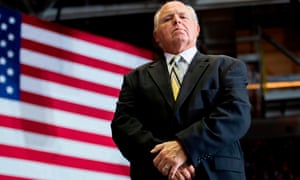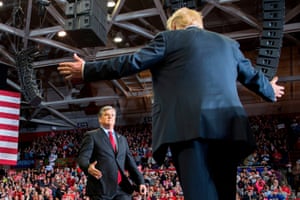Michael Cornfield
 Since the Director of National Intelligence’s (DNI) interagency reportof January 2017, it has been a truth selectively acknowledged that the Russian government took to the US media surreptitiously in 2016 to help elect Donald Trump president. But did it work? Were sufficient numbers of voters persuaded, mobilized and, crucially, demobilized by the efforts of the Internet Research Agency to swing the election in Trump’s favor?
Since the Director of National Intelligence’s (DNI) interagency reportof January 2017, it has been a truth selectively acknowledged that the Russian government took to the US media surreptitiously in 2016 to help elect Donald Trump president. But did it work? Were sufficient numbers of voters persuaded, mobilized and, crucially, demobilized by the efforts of the Internet Research Agency to swing the election in Trump’s favor?
To answer this question sufficiently requires not just additional evidence but also a theory of influence. Two books by top scholars in political communication have now weighed in – and they disagree in their conclusions.
Kathleen Hall Jamieson will have nothing of the euphemistic “meddling” as a descriptor of what the Russians did. She calls it cyberwar and she contends that America lost this battle. Jamieson brings great credentials to her brief, as she immodestly but accurately notes. Her oeuvre includes a peerless evaluation of Ronald Reagan’s visual and verbal rhetoric, standard histories of presidential television advertising and debates, and a dissection of Rush Limbaugh.
Cyberwar, however, is an odd book. It makes a special plead on behalf of Hillary Clinton: Russian trolls and hackers, abetted by the news media, robbed her of the presidency. The case presented is a Jenga tower of suppositions, hypotheticals, concessions, contingencies, qualifications, cherry picks and really good points. Jamieson writes protracted sentences (one has six sentence-length statements stacked up by semi-colons) that wind their way through academically conscientious but progressively dubious lists of the possible causes and effects of Russian interventions in the campaign discourse.
For instance (reviewer takes deep breath): Jamieson argues that news media gatekeepers watched the Sunday morning political talk shows on 9 October 2016 and spread the Russia-fanned notion to elite opinion leaders that, here you have it, Hillary Clinton is irredeemably rotten, and that these leaders in turn swayed colleagues running the first two presidential debates, and that sufficient numbers of debate watchers were turned away from Clinton by the unfairly crafted questions from the moderators to provide victory margins in crucially close midwestern states. Plausible? Yes. Factual? Yes. Conclusive? No, not without audience research data at each step along the pathway of influence. Jamieson supplies it at the second to last step, citing poll data that show a drop in Clinton’s reputation in mid- and late-October. That’s impressive. But attributing it to the Russians elongates the case beyond this reader’s credulity.
A far-right subnetwork traffics in vicious attacks, conspiracy theories and standard-bearers such as Trump
Yochai Benkler, Robert Faris and Hal Roberts, co-authors of Network Propaganda, contend that the Russians added icing on a cake 30 years in the baking. Their main subject is a state of political information disorder or “epistemic crisis”, of which the trolling and hacking affecting the 2016 presidential election are symptomatic.
They document this warp in the public discourse through social network diagrams based on analysis of nearly 4 million online messages sent between 2015 and 2018, data they collected and sorted by telltale phrases: “Hillary Clinton”, “Donald Trump”, “deep state”, “email server”, etc. By including the websites of broadcast and print media, the authors are able to assess most of the media content about the campaigns. Their supervening question: Who linked to whom? Being linked to is an index of influence.
Topic by topic, day by day, these network maps exhibit a disturbing pattern. The galaxy of communications voices and channels in which presidential campaigns occur has been split in two. A legacy, mainstream, familiar subnetwork encompasses the center-right to the far left. Some of its sources make mistakes and spread mischievous and even malicious statements, but these tend to be challenged and corrected from elsewhere. (The Guardian attracted the 10th highest number of in-links, the most of any non-US based source in this grid.)
Meanwhile, a far-right subnetwork traffics in vicious attacks, arrant rumors, conspiracy theories and the valorizing of standard-bearers such as Trump. Its stars include Limbaugh, Steve Bannon, Sean Hannity, Laura Ingraham and Lou Dobbs; its central node is Fox News. This malign subnetwork not only does not repair to standard methods of verification as found in journalism, law, the academy and science, it also vilifies exponents of such methods as agents of oppression. In 2011, the authors note, Limbaugh dubbed these four truth-assessing institutions “the Four Corners of Deceit”.
The propaganda network distracts, disorients, disturbs and manipulates people to achieve certain political goals. For example, Trump’s reactions on Twitter to the release of the DNI report ranged from promising to investigate who leaked it to NBC News, to blaming Democrats for allowing the Russian hacking to succeed, to calling critics of his ties to Russia “stupid”. Those who read and link to the subnetwork are the people who do not acknowledge the truth of the report’s findings.
Given the extensiveness of this subnetwork, the authors assert, the Russian propaganda amplified more than it created. Its trolls and hackers were accessories, not perpetrators. (The same designation applies to Cambridge Analytica and Facebook.) And some of the intrusions were not all that effective. Attacks aimed at alienating Bernie Sanders supporters from Clinton largely failed because those supporters belonged to the evidence-based subnetwork and saw through the gambit.
Benkler, Faris and Roberts weave their findings into a dense but readable narrative that draws on a wide array of political science studies. They conclude that restoration and reunification of the cleaved system of US public communication cannot begin without “a series of electoral defeats that would force such a transformation”. Perhaps that series has begun.
Michael Cornfield is an associate professor of political management at the George Washington University

No comments:
Post a Comment